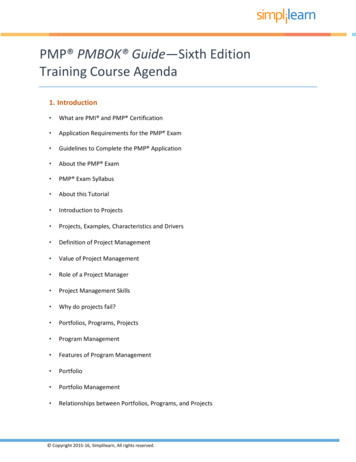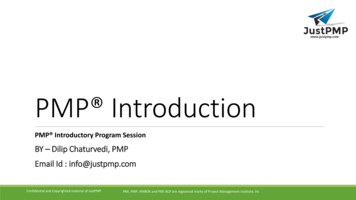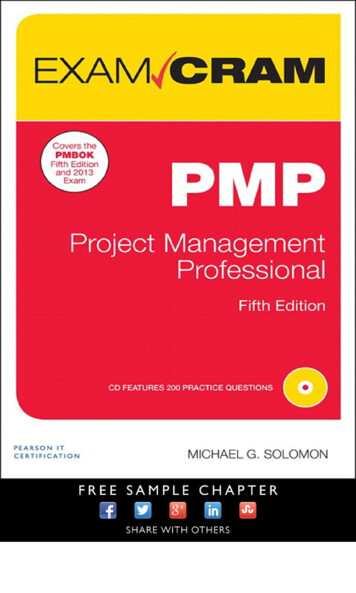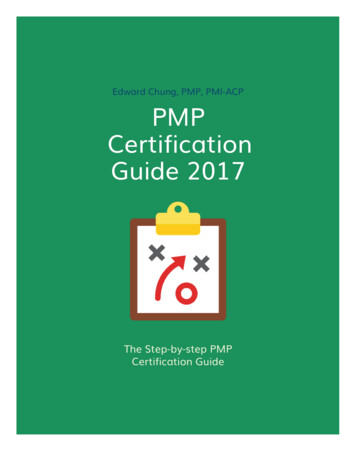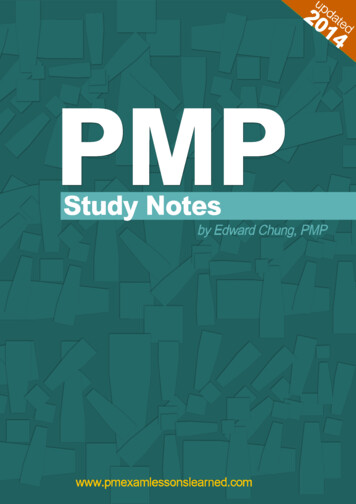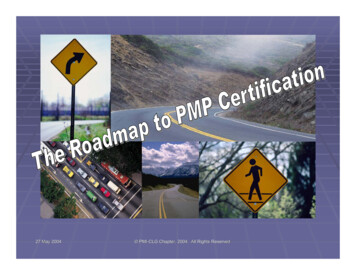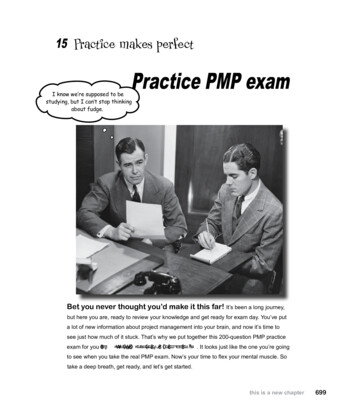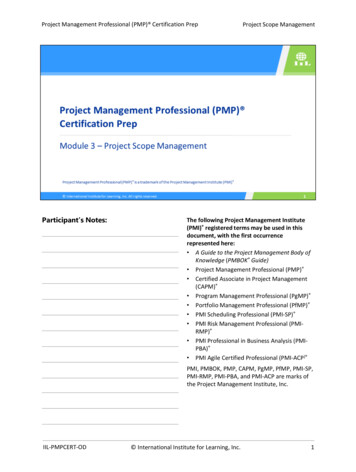
Transcription
Project Management Professional (PMP) Certification PrepParticipant’s Notes:Project Scope ManagementThe following Project Management Institute(PMI) registered terms may be used in thisdocument, with the first occurrencerepresented here: A Guide to the Project Management Body ofKnowledge (PMBOK Guide) Project Management Professional (PMP) Certified Associate in Project Management(CAPM) Program Management Professional (PgMP) Portfolio Management Professional (PfMP) PMI Scheduling Professional (PMI-SP) PMI Risk Management Professional (PMIRMP) PMI Professional in Business Analysis (PMIPBA) PMI Agile Certified Professional (PMI-ACP) PMI, PMBOK, PMP, CAPM, PgMP, PfMP, PMI-SP,PMI-RMP, PMI-PBA, and PMI-ACP are marks ofthe Project Management Institute, Inc.IIL-PMPCERT-OD International Institute for Learning, Inc.1
Project Management Professional (PMP) Certification PrepProject Scope ManagementParticipant’s Notes:IIL-PMPCERT-OD International Institute for Learning, Inc.2
Project Management Professional (PMP) Certification PrepProject Scope ManagementParticipant’s Notes:IIL-PMPCERT-OD International Institute for Learning, Inc.3
Project Management Professional (PMP) Certification PrepParticipant’s Notes:Project Scope ManagementProject Scope Management includes theprocesses required to ensure that the projectincludes all the work required, and only thework required, to complete the projectsuccessfully.PMBOK Guide – Sixth Edition, GlossaryIn the project context, the term scope can referto: Product scope. The features and functionsthat characterize a product, service or result;or Project scope. The work performed todeliver a product, service or result with thespecified features and functions.PMBOK Guide – Sixth Edition, GlossaryWhen a project team delivers more than what isrequired, it is referred to as “gold plating”, and itusually requires more time and cost to deliver.IIL-PMPCERT-OD International Institute for Learning, Inc.4
Project Management Professional (PMP) Certification PrepParticipant’s Notes:IIL-PMPCERT-ODProject Scope ManagementMany projects suffer from “scope creep” for awide variety of reasons. One reason is that thescope of the project was not fully fleshed out atthe beginning (missed requirements) or thatthere was disagreement among thestakeholders as to what the project was allabout. Thus, as the project progressed morefunctionality was added because it was neveridentified in the beginning and thosestakeholders who felt they weren’t heard nowhave a stronger voice in what the end result isgoing to be. This is why this process of PlanScope Management is so vitally important. Thescope management plan lets everyone knowexactly how scope is going to be managed. International Institute for Learning, Inc.5
Project Management Professional (PMP) Certification PrepParticipant’s Notes:Project Scope ManagementThe PMBOK Guide – Sixth Edition defines thefollowing for this first Project ScopeManagement process:Inputs Project charter Project management plan Enterprise environmental factors Organizational process assetsTools & Techniques Expert judgment Data analysis MeetingsOutputs Scope management plan Requirements management planAdapted from: PMBOK Guide – SixthEdition, Part I, Figure 5-1, p. 130IIL-PMPCERT-OD International Institute for Learning, Inc.6
Project Management Professional (PMP) Certification PrepProject Scope ManagementParticipant’s Notes:IIL-PMPCERT-OD International Institute for Learning, Inc.7
Project Management Professional (PMP) Certification PrepProject Scope ManagementParticipant’s Notes:IIL-PMPCERT-OD International Institute for Learning, Inc.8
Project Management Professional (PMP) Certification PrepProject Scope ManagementParticipant’s Notes:IIL-PMPCERT-OD International Institute for Learning, Inc.9
Project Management Professional (PMP) Certification PrepParticipant’s Notes:IIL-PMPCERT-ODProject Scope ManagementThe person who collects requirements (businessanalyst, project manager, system analyst, etc.)will look to stakeholders to provide the featuresand functionality (functional requirements) thatare needed and convert these into technicalrequirements that the product can be builtfrom. During the project life cycle, therequirements will continue to serve as a guide tothe ongoing work. At the end of the project, thefinal deliverables will be examined relative tothe requirements in order to validate the scope. International Institute for Learning, Inc.10
Project Management Professional (PMP) Certification PrepThe PMBOK Guide– Sixth Edition defines theParticipant’sNotes:following for the second Project ScopeManagement process:Inputs Project charterProject Scope ManagementOutputs Requirements documentation Requirements traceability matrixAdapted from: PMBOK Guide – Sixth Edition,Part I, Figure 5-1, p. 130 Project management plan Project documents Business documents Agreements Enterprise environmental factors Organizational process assetsTools & Techniques Expert judgment Data gathering Data analysis Decision making Data representation Interpersonal and team skills Context diagram PrototypesIIL-PMPCERT-OD International Institute for Learning, Inc.11
Project Management Professional (PMP) Certification PrepProject Scope ManagementParticipant’s Notes:IIL-PMPCERT-OD International Institute for Learning, Inc.12
Project Management Professional (PMP) Certification PrepParticipant’s Notes:Project Scope ManagementInterviewsInterviews provide the interaction necessary toelicit the features and functionality needed inthe product/project. They may involve severalrounds, interviewers and interviewees. The titlegiven to a particular group that performs theseinterviews may be “business analyst.”Focus GroupsA group of specialized stakeholders or subjectmatter experts pulled together to collectinformation.Facilitated workshops.These workshops are usually generated to solveproblems, get decisions or to move forward onan expedited schedule. Subject matter expertsand decision makers are in attendance. JointApplication Design meetings (JAD) are anexample of these.IIL-PMPCERT-OD International Institute for Learning, Inc.13
Project Management Professional (PMP) Certification PrepProject Scope ManagementParticipant’s Notes:IIL-PMPCERT-OD International Institute for Learning, Inc.14
Project Management Professional (PMP) Certification PrepProject Scope ManagementParticipant’s Notes:IIL-PMPCERT-OD International Institute for Learning, Inc.15
Project Management Professional (PMP) Certification PrepParticipant’s Notes:Project Scope ManagementUnanimityAll members vote in the same directionMajorityMore than half of the members vote in the samedirectionPluralityLargest block of members voting in the samedirection even if a majority is not reached.DictatorshipOne member’s voice directs the vote.IIL-PMPCERT-OD International Institute for Learning, Inc.16
Project Management Professional (PMP) Certification PrepProject Scope ManagementThe requirements/businessanalyst will determine how to document the requirements and how theyParticipant’sNotes:should be broken down. Frequently this document distinguishes between business requirements,functional requirements and technical requirements (to name a few).The contents of the requirements documentation can include, but are not limited to: Business need Business and project objectives Functional requirements and non-functional requirements, i.e., level of service Quality requirements Acceptance criteria Business rules Impacts to other organizational areas or entities outside the performing organization Support and training Assumptions and constraintsThe Requirements Traceability Matrix (RTM) is a device to track which stakeholder presented therequirement and which deliverables are derived from the requirement. This allows the project teamto evaluate requirements to see if a stakeholder has been missed or perhaps scope is beginning to“creep.” Additionally the same thought process can be applied to deliverables. If you can’t trace adeliverable back to a requirement perhaps a requirement has been missed or maybe scope creep isthe culprit again.IIL-PMPCERT-OD International Institute for Learning, Inc.17
Project Management Professional (PMP) Certification PrepProject Scope ManagementEarly in the planningof a project it is of key importance to describe the scope of the project in aParticipant’sNotes:written document that can serve as a guide to discussions throughout the project about such topics as: Is this feature included in scope? Is this a change to scope?The project charter, requirements documentation, and organizational process assets are used withexpert judgment, product analysis, alternatives justification and facilitated workshops to develop theproject scope statement. The degree and level of detail to which the project scope statement definesthe work that will be performed and the work that is excluded can determine how well the projectmanagement team can control the overall project scope.Note that the scope statement is one of several documents that help describe the scope of a project.Other documents include: The business case The charter The statement of work The requirements The list of deliverables The WBS Contracts RFPs and proposalsIIL-PMPCERT-OD International Institute for Learning, Inc.18
Project Management Professional (PMP) Certification PrepParticipant’s Notes:Project Scope ManagementThe PMBOK Guide – Sixth Edition defines thefollowing for the third Project ScopeManagement process:Inputs Project charter Scope management plan Project documents Requirements documentation Organizational process assetsTools & Techniques Expert judgment Data analysis Decision making Interpersonal and team skills Product analysisOutputs Project scope statement Project documents updatesAdapted from: PMBOK Guide – Sixth Edition,Part I, Figure 5-1, p. 130IIL-PMPCERT-OD International Institute for Learning, Inc.19
Project Management Professional (PMP) Certification PrepProject Scope ManagementParticipant’s Notes:IIL-PMPCERT-OD International Institute for Learning, Inc.20
Project Management Professional (PMP) Certification PrepParticipant’s Notes:IIL-PMPCERT-ODProject Scope ManagementIn Rapid Application Design (RAD) techniques, ameeting of experts and decision makers toenable the team to move forward quickly isreferred to as a Joint Application Design (JAD)session. International Institute for Learning, Inc.21
Project Management Professional (PMP) Certification PrepParticipant’s Notes:Project Scope ManagementAnalysis of AlternativesOne of the most frequently made mistakes inproblem-solving, is the urge to jump to asolution before alternatives are identified. Thefirst step in an analysis of alternatives is toidentify the problem correctly. Next, as manyalternatives need to be surfaced. Later, eachalternative will be evaluated on a predetermined set of criteria.Lateral ThinkingThe term was coined in 1967 by Edward deBono. The thought is to move from a knownidea to a new idea. Often lateral thinking willhelp one identify problems that were notobvious before.Mind MappingA non-linear, graphical way of identifyingattributes of a central theme. Leonardo da Vinciused mind mapping in his notebooks to connectideas. Useful to prevent linear thinking patternsand to explore new relationships.IIL-PMPCERT-OD International Institute for Learning, Inc.22
Project Management Professional (PMP) Certification PrepProject Scope ManagementElements containedin the Scope Statement include, but may not be limited to:Participant’sNotes:Objective(s)A description (who, for whom, why, when, where, what, how and how many) of the projectWhat is NOT in scopeKey Assumptions, Constraints, Deliverables, Stakeholders, Milestones, Resources, Risks & Issues, etc.Preliminary Budget and ScheduleThe objective of the project is a key element in the Scope Statement. It should be concise, but includethe elements to make it SMARTA project scope statement should provide to all stakeholders a common understanding of the projectobjectives and deliverables. The team will continue to iteratively refine and progressively detail thescope until the baseline scope statement is created. The scope statement is the basis for all futureproject decision; therefore, it serves as the foundation for evaluating change requests. The completeddeliverable should address the seven key words listed above.Each one of the questions on the slide may have several answers.IIL-PMPCERT-OD International Institute for Learning, Inc.23
Project Management Professional (PMP) Certification PrepParticipant’s Notes:Project Scope ManagementPMBOK Guide – Sixth Edition, pages 154-155provides more detail on each element of theproject scope statement, which may provehelpful when completing this exercise.Keep in mind the following seven key words,and use them to verify the completeness ofyour deliverable:1. Who?2. What?3. When?4. Why?5. Where?6. How?7. How many?IIL-PMPCERT-OD International Institute for Learning, Inc.24
Project Management Professional (PMP) Certification PrepParticipant’s Notes:IIL-PMPCERT-ODProject Scope ManagementThere is no more important deliverable inproject management than the WBS. It containsall the work needed to be complete to completethe project. Without one, how would you knowif you’ve captured all the work that needs to beaccomplished? International Institute for Learning, Inc.25
Project Management Professional (PMP) Certification PrepParticipant’s Notes:Project Scope ManagementThe PMBOK Guide – Sixth Edition defines thefollowing for the fourth Project ScopeManagement process:Inputs Project management plan Project documents Enterprise environmental factors Organizational process assetsTools & Techniques Decomposition Expert judgmentOutputs Scope baseline Project documents updatesAdapted from: PMBOK Guide – Sixth Edition,Part I, Figure 5-1, p. 130IIL-PMPCERT-OD International Institute for Learning, Inc.26
Project Management Professional (PMP) Certification PrepParticipant’s Notes:IIL-PMPCERT-ODProject Scope ManagementRemember that Enterprise EnvironmentalFactors (EEFs) and Organizational Process Assets(OPAs) are specific to the process they support. International Institute for Learning, Inc.27
Project Management Professional (PMP) Certification PrepProject Scope ManagementParticipant’s Notes:IIL-PMPCERT-OD International Institute for Learning, Inc.28
Project Management Professional (PMP) Certification PrepParticipant’s Notes:Project Scope ManagementInputs for this exercise are PMBOK Guide –Sixth Edition and Project Management: ASystems Approach to Planning, Scheduling, andControlling, 12th Edition by Harold Kerzner,Ph.D., Chapter 11, p. 365-372.Listen for specific directions from yourinstructor.This exercise provides you with practicalexperience and support from team members indeveloping a Work Breakdown Structure.The Create WBS process includes not only theWBS as an output, but also the WBS Dictionary.The WBS Dictionary is a document generated bythe process that supports the WBS and caninclude such information as responsibleorganization, required resources, cost estimates,work description, etc.The WBS dictionary cannot be completed untilthe processes used to produce the schedule andcost baselines are completed that are in theProject Schedule Management and Project CostManagement Knowledge Areas.IIL-PMPCERT-OD International Institute for Learning, Inc.29
Project Management Professional (PMP) Certification PrepProject Scope ManagementParticipant’s Notes:IIL-PMPCERT-OD International Institute for Learning, Inc.30
Project Management Professional (PMP) Certification PrepParticipant’s Notes:Project Time ManagementReview these learning objectives carefully.The learning content contained within thismodule is based on these learning objectives.At the end of this module or the end of thecourse, you should be able to answer quiz ortest questions related to these learningobjectives.If you are participating in this course forcertification, you will be better prepared to passa certification exam by recalling these learningobjectives.IIL-PMPCERT-OD International Institute for Learning, Inc.31
Project Management Professional (PMP) Certification PrepParticipant’s Notes:IIL-PMPCERT-ODProject Scope ManagementExercise Debrief: The exercise debrief will be ledby the course leader and conducted within thelarge group. Each team will review their WorkBreakdown Structure for comments/questionsfrom the large group. International Institute for Learning, Inc.32
Project Management Professional (PMP) Certification PrepProject Scope ManagementParticipant’s Notes:IIL-PMPCERT-OD International Institute for Learning, Inc.33
Project Management Professional (PMP) Certification PrepParticipant’s Notes:Project Scope ManagementIs a project successful if, as a project manager,you’ve met the time, cost and scoperequirements? No. The client has to be satisfied.That’s why scope validation is so important. Byvalidating scope, meaning reviewing thedeliverables for acceptance, the client willconfirm whether he or she is indeed satisfiedwith the project.Scope validation and quality control are oftenconfused. Scope validation has to do with thecompleteness of the deliverables and is focusedon meeting the requirements and acceptance bythe client (internal or external). Quality controlfocuses on the correctness of the workcompleted. Quality control is something thatshould take place throughout the project, whilescope validation takes place at the end of aphase or the project. Large deliverables can bevalidated throughout the project.IIL-PMPCERT-OD International Institute for Learning, Inc.34
Project Management Professional (PMP) Certification PrepParticipant’s Notes:Project Scope ManagementThe PMBOK Guide – Sixth Edition defines thefollowing for the fifth Project ScopeManagement process:Inputs Project management plan Project documents Verified deliverables Work performance dataTools & Techniques Inspection Decision-makingOutputs Accepted deliverables Work performance information Change requests Project documents updatesAdapted from: PMBOK Guide – Sixth Edition,Part I, Figure 5-1, p. 130IIL-PMPCERT-OD International Institute for Learning, Inc.35
Project Management Professional (PMP) Certification PrepParticipant’s Notes:Project Scope ManagementScope validation uses inputs in conjunction withthe key technique – inspection to achieve thedesired result of accepted deliverables. The project management plan contains thescope baseline. The requirements documentation lists allthe project, product, technical and othertypes of requirements. The requirements traceability matrix linksrequirements to their origin and maintainstraceability of the requirementsthroughout the project life cycle. Verified deliverables are those that arecompleted or checked for correctness bythe quality control process.IIL-PMPCERT-OD International Institute for Learning, Inc.36
Project Management Professional (PMP) Certification PrepParticipant’s Notes:IIL-PMPCERT-ODProject Scope ManagementScope validation is all about determining if theoutcomes of the project are acceptable. Theclient or sponsor must formally sign off andapprove the deliverables based on acceptancecriteria. Deliverables that are not formallyaccepted are documented, along with thereasons for non-acceptance. The deliverablesnot accepted may require a change request fordefect repair. International Institute for Learning, Inc.37
Project Management Professional (PMP) Certification PrepParticipant’s Notes:IIL-PMPCERT-ODProject Scope ManagementThe process of controlling scope is closelyassociated with all other control points withinthe project. Once a change is approved, it isextremely important that it is communicated tothe stakeholders. “The plan has now changed!”Often throughout a project requests for changeswill occur from both the external stakeholdersand/or the team. Without a way to controlwhich changes are appropriate and those thatare not, scope creep could become a seriousproblem, robbing resources dedicated to oneproject to cover costs in another. Controllingscope entails the documentation of the request,the review of the request (by a change controlboard (CCB) or similar authority), and theapproval/denial of the change. This is a part ofperforming integrated change management.The changes we are discussing here could alsoinclude corrective and preventive actions takenduring the project life cycle. International Institute for Learning, Inc.38
Project Management Professional (PMP) Certification PrepParticipant’s Notes:Project Scope ManagementThe PMBOK Guide – Sixth Edition defines thefollowing for the sixth Project ScopeManagement process:Inputs Project management plan Project documents Work performance data Organizational process assetsTools & Techniques Data analysisOutputs― Work performance information Change requests Project management plan updates Project documents updatesAdapted from: PMBOK Guide – SixthEdition, Part I, Figure 5-1, p.130IIL-PMPCERT-OD International Institute for Learning, Inc.39
Project Management Professional (PMP) Certification PrepParticipant’s Notes:Project Scope ManagementChange is inevitable, thereby mandating sometype of control process. The Control Scopeprocess uses the Project Management Plan as akey input because the Project Management Planincludes the scope baseline and the plans formanaging scope, change, and configurations.Work performance data provides details on theproject progress, i.e., deliverables that havestarted and completed.Additional inputs for this process are: Requirements documentation Requirements traceability matrix Organizational process assetsIIL-PMPCERT-OD International Institute for Learning, Inc.40
Project Management Professional (PMP) Certification PrepParticipant’s Notes:Project Scope ManagementUncontrolled changes are often referred to asscope creep which is not acceptable in theproject environment. The elimination of scopecreep requires change management to be inplace and actively working within theorganization. A change management plandefines the process for managing change on theproject. In managing change to scope, projectperformance measures are used to assess themagnitude of variation from the original scopebaseline.Important aspects of project scope controlinclude determining the cause and degree ofvariance relative to the scope baseline anddeciding whether to take corrective orpreventive action.IIL-PMPCERT-OD International Institute for Learning, Inc.41
Project Management Professional (PMP) Certification PrepParticipant’s Notes:IIL-PMPCERT-ODProject Scope ManagementThe change control process will also assist inmanaging scope creep by detecting changes thatare not submitted as requests or by processingchanges that were implemented withoutfollowing the process. These types of changesmay be detected by comparing work resultswith project baselines or revealed through theverification of scope. Variances must beconsidered potential drivers for a changerequest; therefore, an analysis should beperformed to determine the impact. International Institute for Learning, Inc.42
Project Management Professional (PMP) Certification PrepParticipant’s Notes:IIL-PMPCERT-ODProject Scope ManagementThe analysis of scope performance, based onwork performance measurements, could resultin a change request to the scope baselineand/or other components of the projectmanagement plan, as well as the requirementsdocumentation and requirements traceabilitymatrix. If there are learned lessons to becaptured, organizational process updates willinclude causes of variance, corrective orpreventive actions, and rationales for theseactions. International Institute for Learning, Inc.43
Project Management Professional (PMP) Certification PrepParticipant’s Notes:Project Stakeholder ManagementWhen we make errors or omissions, we takeownership and make corrections promptly.When we discover errors or omissions caused byothers, we communicate them to theappropriate body as soon they are discovered.We accept accountability for any issues resultingfrom our errors or omissions and any resultingconsequences.It is common to make errors in gatheringrequirements or leave out a requirement anddiscover it later. We need to take responsibilityfor any errors or omissions on our part andcommunicate the error and the impact to theaffected parties.We fulfill the commitments that we undertake;we do what we say we will do.Part of defining and managing scope is insuringthat we only commit to the scope we canaccomplish. We have a responsibility to disclosethose aspects of scope that we are not certainwe can complete.IIL-PMPCERT-OD International Institute for Learning, Inc.44
Project Management Professional (PMP) Certification PrepProject Stakeholder ManagementParticipant’s Notes:IIL-PMPCERT-OD International Institute for Learning, Inc.45
Project Management Professional (PMP) Certified Associate in Project Management (CAPM) Program Management Professional (PgMP) Portfolio Management Professional (PfMP) PMI Scheduling Professional (PMI-SP) PMI Risk Management Professional (PMI-RMP) PMI Professional in Business Analysis (PMI-PBA)
